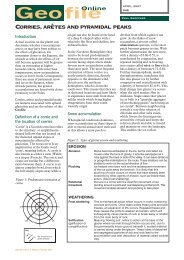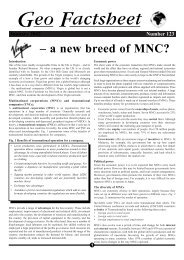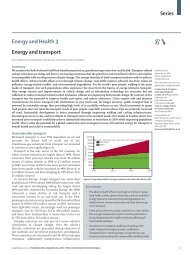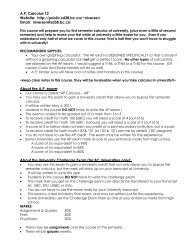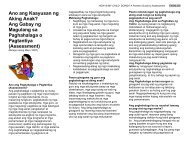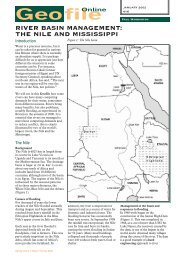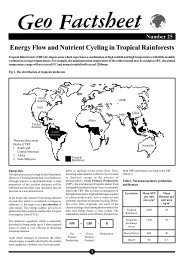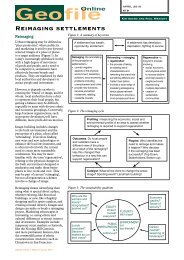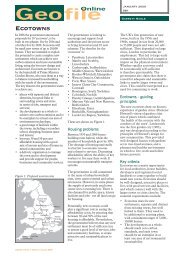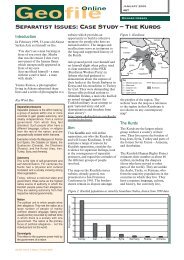80 Antartica.pdf - Richmond School District No. 38
80 Antartica.pdf - Richmond School District No. 38
80 Antartica.pdf - Richmond School District No. 38
You also want an ePaper? Increase the reach of your titles
YUMPU automatically turns print PDFs into web optimized ePapers that Google loves.
Antarctica<br />
Geo Factsheet<br />
There is an on-going debate about the management of Antarctica. Some believe the Antarctica Treaty is working, others believe Antarctica would<br />
be better protected if it were made a World Park (Table 3).<br />
Table 3. How should Antarctica be managed<br />
Options<br />
Managing Antarctica<br />
Maintaining the treaty<br />
For<br />
The treaty has worked - there has been no attempt<br />
to exploit mineral resources and no military<br />
development has occurred.<br />
CCAMLR provides legal protection for marine<br />
life.<br />
CRAMRA will protect the Antarctic environment<br />
against damaging mineral exploration.<br />
Against<br />
Very difficult to show that ‘scientific research’ is not<br />
exploration for minerals. Although parties are meant<br />
to share information, very little real information<br />
sharing may occur.<br />
Protection depends upon every party agreeing rather<br />
than a majority basis - CCAMLR has not prevented<br />
any exploration of seals, whales and finfish.<br />
Any form of mineral exploration will damage<br />
Antarctica - CRAMRA merely provides a framework<br />
to allow mining rather than prohibit it.<br />
World Park<br />
A WP Treaty would be based upon the<br />
precautionary principle whereby those wishing to<br />
conduct any activity would be required to prove that<br />
there would be no harmful environmental effects.<br />
Mining and exploration would be banned<br />
permanently. The overriding principles would be<br />
peace, co-operation and preservation of wilderness.<br />
Would be very difficult to get agreement between<br />
present signatories. A complete ban leaves no room<br />
for discussion or compromise and would, therefore,<br />
be bound to fail. Without any possibility of future<br />
resource exploration, funding of scientific research<br />
would decline.<br />
3. Minerals<br />
Antarctica has huge potential or speculative resources.<br />
Three main ‘metallogenic’ areas have been identified (Fig 6).<br />
1. East Antarctica<br />
2. Transarctic Mountains<br />
3. Andean Province<br />
Fig 6. Main metallogenic areas of Antarctica<br />
Iron<br />
sub-province<br />
Iron Oxide Vein<br />
sub-province<br />
Copper<br />
sub-province<br />
East Antarctic<br />
Iron Metallogenic<br />
province<br />
Iron-Formation<br />
sub province<br />
Prince<br />
Charles<br />
mountains<br />
South pole<br />
Transantarctic<br />
metallogenic<br />
province<br />
Acknowledgements; This Factsheet was researched and written by Kevin Byrne. Geopress Factsheets may be<br />
copied free of charge by teaching staff or students, provided that their school is a registered subscriber. <strong>No</strong> part<br />
of these Factsheets may be reproduced, stored in a retrieval system, or transmitted, in any other form or by any<br />
other means, without the prior permission of the publisher. ISSN 1351-5136<br />
Most interest has focused on the potential resources of coal, hydrocarbons<br />
and manganese nodules. Coal occurs in Permian and Triassic strata and<br />
the largest quantities occur in the Permian sandstones in the Transantarctic<br />
Mountains. However, at this time the problems of exploiting this resource<br />
seem to prevent economic development.<br />
The most likely sites of hydrocarbons are along the coast of West Antarctica.<br />
The Ross Sea Basin includes three deep troughs filled with sediment and<br />
therefore, probably oil. A major problem in exploiting such resources will<br />
be their depth - the continental shelf has an average cross sectional depth of<br />
500m whilst the average elsewhere in the world is 200m. In addition,<br />
extensive areas of the sea floor are prone to mass movement, gas release<br />
and volcanism - all serious potential hazards.<br />
The 1988 Convention on the Regulation of Antarctic Mineral<br />
Resource Activities (CRAMRA) prohibits mineral exploration unless all<br />
the signatories agree that it could be carried out without environmental<br />
damage. CRAMRA was introduced before there was any clear evidence<br />
that the Antarctic contained valuable minerals. Its supporters say that<br />
such an approach was necessary given the huge potential damage of any<br />
exploration. Its opponents argue that the Convention merely raised<br />
awareness of the potential for exploitation and made it more difficult for<br />
Antarctica to be granted World Park status.<br />
The Madrid Protocol adopted in 1991 prohibits mining but the prohibition<br />
can be lifted if all parties agree. The Protocol also designated Antarctica as<br />
a natural reserve, established environmental principles for the conduct of<br />
all activities and established the need for environmental impact assessment<br />
(EIA) for any actions.<br />
The 1989 sinking of the Bahio Paraiso near Anvers Island and the Exxon<br />
Valdez oil spill in Alaska have increased public concern about possible<br />
harmful effects of minerals activity in Antarctica. However, the ultimate<br />
constraints on resource exploitation in Antarctica are likely to be political<br />
and economic rather than environmental.<br />
4



